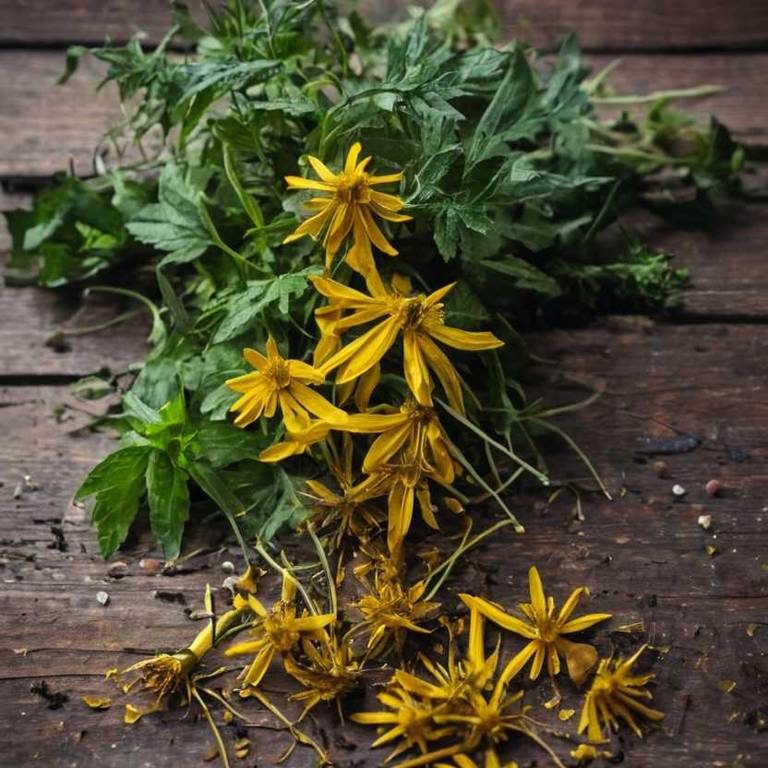By Leen Randell
Updated: Jul 06, 2024
What to know about Ligularia dentata (toothed leaf) before using it medicinally

Ligularia dentata, commonly known as toothed leaf, is a herb rich in antioxidants and anti-inflammatory properties, which contribute to improved cardiovascular health and reduced inflammation in the body.
As a garden plant, Ligularia dentata is valued for its architectural foliage and vibrant yellow daisy-like flowers that attract pollinators and add color to summer borders. Botanically, the plant belongs to the Asteraceae family and is known for its distinctive toothed leaves and tall flower spikes.
Historically, Ligularia dentata has been used in traditional Chinese medicine for its therapeutic properties and is still referenced in modern herbal remedies.
This article explains the medicinal, horticultural, botanical, and historical aspects of Ligularia dentata.
What are the medicinal properties of Ligularia dentata?
Ligularia dentata helps with various ailments such as fever, rheumatism, and bronchitis due to its anti-inflammatory and antimicrobial properties. Its leaves and roots are used in traditional medicine to treat respiratory issues and skin problems.
The active constituents responsible for its medicinal properties include sesquiterpene lactones, flavonoids, and triterpenoids. These compounds exhibit anti-inflammatory, antioxidant, and immunomodulatory activities. The chemical composition of the plant contributes to its effectiveness in treating various health conditions.
The leaves and roots are the most commonly used parts of the plant for medicinal purposes. The leaves are used to treat fever and rheumatism, while the roots are used to treat bronchitis and skin problems. The plant's parts are often dried and prepared as infusions or decoctions.
Improper use of Ligularia dentata can lead to side effects such as allergic reactions, gastrointestinal upset, and interact with other medications. The plant's sesquiterpene lactones may also cause skin irritation and phototoxicity in some individuals.
Precautions when using Ligularia dentata medicinally include consulting a healthcare professional, especially for pregnant or breastfeeding women, and individuals with allergies or sensitivities. The plant's active constituents may interact with other medications, so it's essential to disclose its use to healthcare providers.
What are the horticulural aspects of Ligularia dentata?
Ligularia dentata grow well in full sun to partial shade, requiring at least 4-6 hours of direct sunlight per day. They prefer moist, fertile soils with a pH range of 5.5-7.5 and are tolerant of a wide range of soil types.
Planting tips for Ligularia dentata include planting in early spring or fall to avoid extreme temperatures. Space plants 3-4 feet apart to allow for proper air circulation and growth. Water thoroughly after planting and keep the soil consistently moist during the first growing season. Mulch around the base to retain moisture and suppress weeds.
Harvesting tips for Ligularia dentata involve cutting off spent flowers to promote new blooms and prevent seed production. Deadheading can be done throughout the growing season, but avoid cutting back stems in late fall or early spring. Allow the foliage to die back naturally before cutting it back to the ground.
Common pests and diseases affecting Ligularia dentata include aphids, slugs, and snails, as well as powdery mildew and leaf spot diseases. Regular monitoring and treatment with insecticidal soap or neem oil can help control pest populations. Fungicides can be used to treat fungal diseases, but cultural controls like improving air circulation and reducing moisture may also be effective.
What are the botanical aspects of Ligularia dentata?
Ligularia dentata is a perennial herbaceous plant with coarse, toothed leaves and tall, conical spikes of yellow flowers. The leaves are simple, ovate, and dentate, with serrated margins and a leathery texture. The inflorescence is a dense, cylindrical spike of small, yellow flowers.
The taxonomical classification of Ligularia dentata places it in the family Asteraceae, subfamily Carduoideae, and genus Ligularia. It is a member of the Ligularia genus, which comprises 80-100 species of plants, mostly native to East Asia. The species epithet "dentata" refers to the toothed leaves.
There are several variants of Ligularia dentata, including 'Britt-Marie Crawford', 'Milk Chocolate', and 'Thunderbolt', which exhibit variations in leaf size, flower color, and plant habit. Some variants are selected for their ornamental value in gardens and landscaping.
Ligularia dentata is native to East Asia, including China, Japan, and Korea. It grows in mountainous regions, typically in moist, woodland areas at elevations of 1,000-2,000 meters above sea level. It is naturalized in parts of Europe and North America, where it has become invasive in some areas.
The life cycle of Ligularia dentata begins with seed germination in spring, followed by vegetative growth and flower spike formation. The plant produces seeds in mid-to-late summer, which are dispersed by wind and water. The seeds germinate the following spring, repeating the cycle.
What are the historical aspects of Ligularia dentata?
Ligularia dentata is a plant with a rich history of use in traditional medicine. In ancient China, the leaves and roots were used to treat fever, rheumatism, and other ailments. The plant's antiseptic and anti-inflammatory properties made it a valuable remedy.
In Japanese mythology, Ligularia dentata was associated with the god of war, Hachiman, and was believed to possess sacred powers. According to legend, the plant's leaves could bring good fortune and protection in battle.
Throughout history, Ligularia dentata has been imbued with symbolic meanings. In Japan, the plant's large, toothed leaves symbolize the power of the wind and the beauty of nature. In China, the plant's yellow flowers represent good luck and prosperity.
The earliest written records of Ligularia dentata date back to the 16th-century Materia Medica, a Chinese medical text attributed to the physician Li Shizhen. The text describes the plant's properties and uses in detail, highlighting its value in treating various ailments.
Historical artifacts from ancient China, such as ceramics and bronze vessels, feature depictions of Ligularia dentata. These artworks showcase the plant's significance in Chinese culture and art, demonstrating its enduring impact on society and aesthetics.